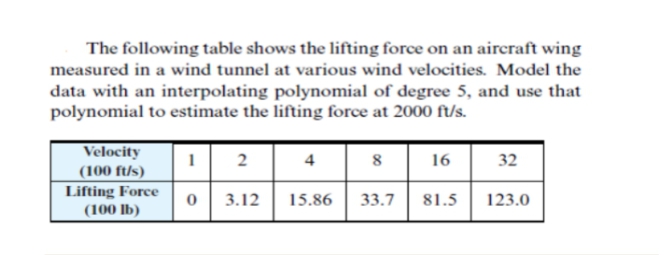The following table shows the lifting force on an aircraft wing measured in a wind tunnel at various wind velocities. Model the data with an interpolating polynomial of degree 5, and use that polynomial to estimate the lifting force at 2000 ft/s. Velocity 4 8 16 32 (100 ft/s) Lifting Force (100 lb) 3.12 15.86 33.7 81.5 123.0
The following table shows the lifting force on an aircraft wing measured in a wind tunnel at various wind velocities. Model the data with an interpolating polynomial of degree 5, and use that polynomial to estimate the lifting force at 2000 ft/s. Velocity 4 8 16 32 (100 ft/s) Lifting Force (100 lb) 3.12 15.86 33.7 81.5 123.0
Algebra & Trigonometry with Analytic Geometry
13th Edition
ISBN:9781133382119
Author:Swokowski
Publisher:Swokowski
Chapter4: Polynomial And Rational Functions
Section4.3: Zeros Of Polynomials
Problem 66E
Related questions
Question

Transcribed Image Text:The following table shows the lifting force on an aircraft wing
measured in a wind tunnel at various wind velocities. Model the
data with an interpolating polynomial of degree 5, and use that
polynomial to estimate the lifting force at 2000 ft/s.
Velocity
|(100 ft/s)
Lifting Force
(100 lb)
2
4
8
16
32
3.12
15.86
33.7
81.5
123.0
Expert Solution
This question has been solved!
Explore an expertly crafted, step-by-step solution for a thorough understanding of key concepts.
This is a popular solution!
Trending now
This is a popular solution!
Step by step
Solved in 8 steps

Knowledge Booster
Learn more about
Need a deep-dive on the concept behind this application? Look no further. Learn more about this topic, calculus and related others by exploring similar questions and additional content below.Recommended textbooks for you

Algebra & Trigonometry with Analytic Geometry
Algebra
ISBN:
9781133382119
Author:
Swokowski
Publisher:
Cengage

Algebra & Trigonometry with Analytic Geometry
Algebra
ISBN:
9781133382119
Author:
Swokowski
Publisher:
Cengage